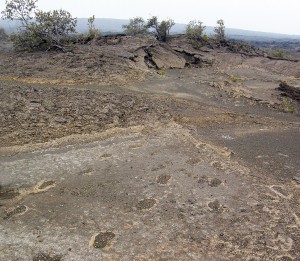220 years ago, an explosive eruption on the slopes of Kilauea Volcano killed more than 80 people. On Friday, the deadly event will be the topic of a presentation at the University of Hawaii at Hilo.
Hawaiian Volcano Observatory geologist Don Swanson will explain what happened during that eruption, which was Kilauea ‘s largest explosion in 1,000 years. To this day, preserved footprints – made in the muddy ash during the eruption – are reminders of the volcanic fury experienced by the Hawaiian people on that day.
Swanson has spent 10 years of field work on Kilauea studying the event, and his findings provide a sketch of what can be expected during Kilauea’s next violent explosive eruption. According to a media release, quote: “the picture isn’t pretty.”
The free presentation will take place at 7:00 p.m. in Wentworth Hall 1 on the UH–Hilo main campus. The event is one of many programs offered by HVO during Hawaii Island’s second annual Volcano Awareness Month in January.
Visit the HVO Web site or call (808) 967-8844 for more information.
HVO issued this media release about the talk:
HAWAII NATIONAL PARK, Hawaii – An explosive eruption that killed more than 80, and possibly several hundred, people on Kīlauea Volcano’s slopes 220 years ago will be the topic of a presentation at the University of Hawai‘i at Hilo on Friday, January 7.
Don Swanson, a geologist with the U.S. Geological Survey’s Hawaiian Volcano Observatory (HVO), will give the free presentation on the 1790 eruption at 7:00 p.m. in Wentworth Hall 1 on the UH–Hilo main campus, 200 W. Kawili Street, in Hilo. A map of the campus is online: http://hilo.hawaii.edu/images/maps/main_campus_map.pdf.
In 1790, many people died during Kīlauea Volcano’s largest explosive eruption in 1,000 years. What happened during that eruption? Why were there fatalities? Swanson has spent 10 years of field work on Kīlauea to find the answers to these questions.
According to Swanson, his findings provide a sketch of what can be expected during Kīlauea’s next violent explosive eruption, and “the picture isn’t pretty.” He will share what he and his colleagues have learned about Kīlauea’s 1790 eruption in his presentation.
The start of the 1790 eruption remains enigmatic, but Swanson’s ongoing research indicates that the eruption had several violent stages, all of which were potentially deadly. This conclusion is based on his extensive investigation of volcanic deposits produced by the explosive events. Swanson says these layered geologic deposits can be “read” like chapters in a book to reveal the story of the eruption.
This presentation is one of many programs offered by HVO during Hawai‘i Island’s second annual Volcano Awareness Month (January 2011). For more information about this talk and other Volcano Awareness Month events, visit the HVO Web site at http://hvo.wr.usgs.govor call (808) 967-8844.
For eruption updates and information on recent earthquakes in Hawai’i, visit the Hawaiian Volcano Observatory website at http://hvo.wr.usgs.gov.
***USGS***
The USGS serves the nation by providing reliable scientific information to: describe and understand the Earth; minimize loss of life and property from natural disasters; manage water, biological, energy, and mineral resources; and enhance and protect our quality of life.
This press release and in-depth information about USGS programs may be found on the USGS home page: http://www.usgs.gov.


by Big Island Video News10:35 am
on at
STORY SUMMARY
By Tim Bryan 220 years ago, an explosive eruption on the slopes of Kilauea Volcano killed more than 80 people. On Friday, the deadly event will be the topic of a presentation at the University of Hawaii at Hilo. Hawaiian Volcano Observatory geologist Don Swanson will explain what happened during that eruption, which was Kilauea […]